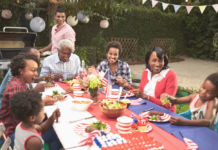Looking to create a dementia-friendly environment? Proper dementia care extends beyond memory care decorating ideas to involve safety precautions (like dementia signs for home).
From the fun to the functional things you can do to enrich the life of an individual with dementia, here are all the tips you need for a dementia-friendly home.
What Does Dementia Friendly Mean?
Being dementia friendly means more than just being friendly. The push for dementia-friendly communities is actually a movement that brings to light the need for human rights and disability rights for people with dementia.
Those caring for dementia patients and loved ones know what a big impact the disease can have. The goal of dementia-friendly rooms, homes, and environments is to empower independence within a safe community.
Experts believe organizations can make minor adjustments, like adding wheelchair ramps, to make their environment more accessible for those with dementia. Small but significant changes like this can enable people with dementia to have a better quality of life and feel more connected to their community.
This initiative is more than simple adjustments, though. The concept of becoming “dementia-friendly” can be a framework and a fundamental part of meeting community needs.
Meeting a person’s physical and safety needs is just a baseline. The goal is to have more holistic environments that allow those with dementia to live with the best quality.
What Are Dementia Friendly Communities?
Some cities unknowingly exclude those who have dementia. From 2021 to 2050, the projected number of individuals with dementia is expected to grow from 58 million to 88 million. Despite this projection, many communities are not equipped to deal with their populations in a dementia-friendly way.
Dementia-friendly communities are composed of people who are safe, informed, and respectful regarding individuals with this disease. It supports families and caregivers with options for fostering increased quality of life. They enable processes and engage representatives who can promote dementia-friendly policies.
So, what are practical steps to making communities more dementia-friendly? Beyond enacting the tips listed below, you can look into your environment and see how dementia-friendly it is in the following areas:
- Technical assistance
- Community toolkits and resources
- Sector-specific guidance (i.e. communication tips for doctors, outreach for caregivers)
- Support groups
- Recognition criteria
- Community events
- Staff education
- Care protocol
- Environmental modifications
Can’t find a community enacting change in your area? It might be time to take things into your own hands. If you want to make an impact, you can think about establishing your own chapter of an existing organization or even starting your own.
How to Design A Dementia-Friendly Care Environment
Making space dementia-friendly involves intentional actions. You may need to move throughout your day thinking about how difficult an activity would be if you had dementia. Doing this can help you find areas for improvement and where you can aim for change.
The following seven ideas are ways you can make your home more dementia-friendly today.
Remember, Safety First
It is important to create a sense of safety and also safely support daily activities. This may mean providing emotional support day-to-day as dementia worsens.
It could also mean installing equipment (like better lighting) or purchasing technology (like dementia-friendly eating utensils) that allows daily tasks to be accomplished with more ease.
Stay Activity-Minded
While on the topic of safety, it’s incredibly crucial to encourage someone with dementia to engage in safe movement and exercise. Keeping up the appropriate level of activity is key in supporting skills like balance, walking, and strength.
Dementia is a fickle disease, so sometimes muscle memory, dancing, or music may be able to spark a moment of remembering and get an elderly friend engaged in the activity.
Spend Time Listening
Dementia can be painful for both the person being cared for and the caregiver. Sometimes, lending a listening ear can be all that an individual needs.
Those with memory loss may tell you the same story over and over. This can be an opportunity to improve until you find a response that works and helps them better function in a certain situation.
Use Sticky Notes and Dementia Signs for Home
Even for individuals without dementia, signs and symbols can be helpful. Putting pictures around your kitchen or bathroom, for instance, can help someone with dementia better identify where their things are.
Keeping regularly used items, like keys, wallets, and phones in the same place can also help you to adapt your home to be a more dementia-friendly environment.
Be Simple and Clutter-Free
Contrasting colors and clearing away clutter can help simplify the home environment. This may not seem important, but untidy spaces and colors that do not contrast can be confusing or distracting to individuals with dementia.
The good news? Making these dementia-friendly shifts is often inexpensive and easy to do.
One way to simplify things is to use a senior-focused meal delivery system. We are obviously big fans of Silver Cuisine, our chef-curated meal delivery program designed to serve seniors, but we know there are other great options out there, too!
Delivery programs can remove health hazards, like knives in the kitchen, and also provide mealtime relief to tired caregivers or spouses.
Install Sensors and Alarms
People with dementia are sometimes prone to wander or forget what they are doing in the middle of an activity. As a caregiver, it can be helpful (and may even save a life) if you install smoke alarms, carbon monoxide alarms, and other detectors.
There are even dementia-friendly devices that have been designed to detect if water is left running or temperatures have risen or dropped to an unsafe level.
Create a Careful Garden
The garden can be an absolutely integral space that allows those with dementia and their caregivers some much-needed fresh air. Being outside has important effects, including boosting vitamin D in the body relieving stress, and regulating the sleep cycle.
Be sure to integrate items such as:
- Safe and clear steps on stairs (i.e. painting a noticeable line to distinguish one step from another)
- A seat, preferably with an option of shade (i.e. an umbrella)
- A garden gate (allows someone to wander safely within the garden space)
A Final Word On Dementia Friendly Environments
Yes, dementia-friendly environments involve some effort. However, these initiatives are crucial to improving society and making it a safer place for people with dementia.
Luckily, some of the most important steps start by making your own home more safe and supportive for loved ones with dementia.
References:
10 ways to make your home dementia friendly. Alzheimer’s Society. Published December 2017. https://www.alzheimers.org.uk/blog/10-ways-make-your-home-dementia-friendly.
2022 Alzheimer’s Disease Facts and Figures. Alzheimer’s Association. Published 2022. https://www.alz.org/media/Documents/alzheimers-facts-and-figures.pdf.
Allen K. Making Your Home Dementia Friendly. Alzheimer’s Disease Research. Published July 2021. https://www.brightfocus.org/alzheimers/article/making-your-home-dementia-friendly.
Dementia Friendly Communities. Alzheimer’s Disease International. https://www.alzint.org/u/dfc-principles.pdf.
Lin SY. ‘Dementia-friendly communities’ and being dementia-friendly in healthcare settings. Curr Opin Psychiatry. 2017;30(2):145-150.
McMorrow P. 7 Dementia Care Tips From a Caregiver Who Understands. Caring Bridge. Published April 2019. https://www.caringbridge.org/resources/dementia-caregiver-tips/?gclid=CjwKCAjwve2TBhByEiwAaktM1IysQya2ZAM214rWonnLYRLNT48Xg6K_JweqtKWWrSqgFjRNlvskeRoCGDgQAvD_BwE&gclsrc=aw.ds.
What Is DFA? Dementia Friendly America. https://www.dfamerica.org/what-is-dfa.






